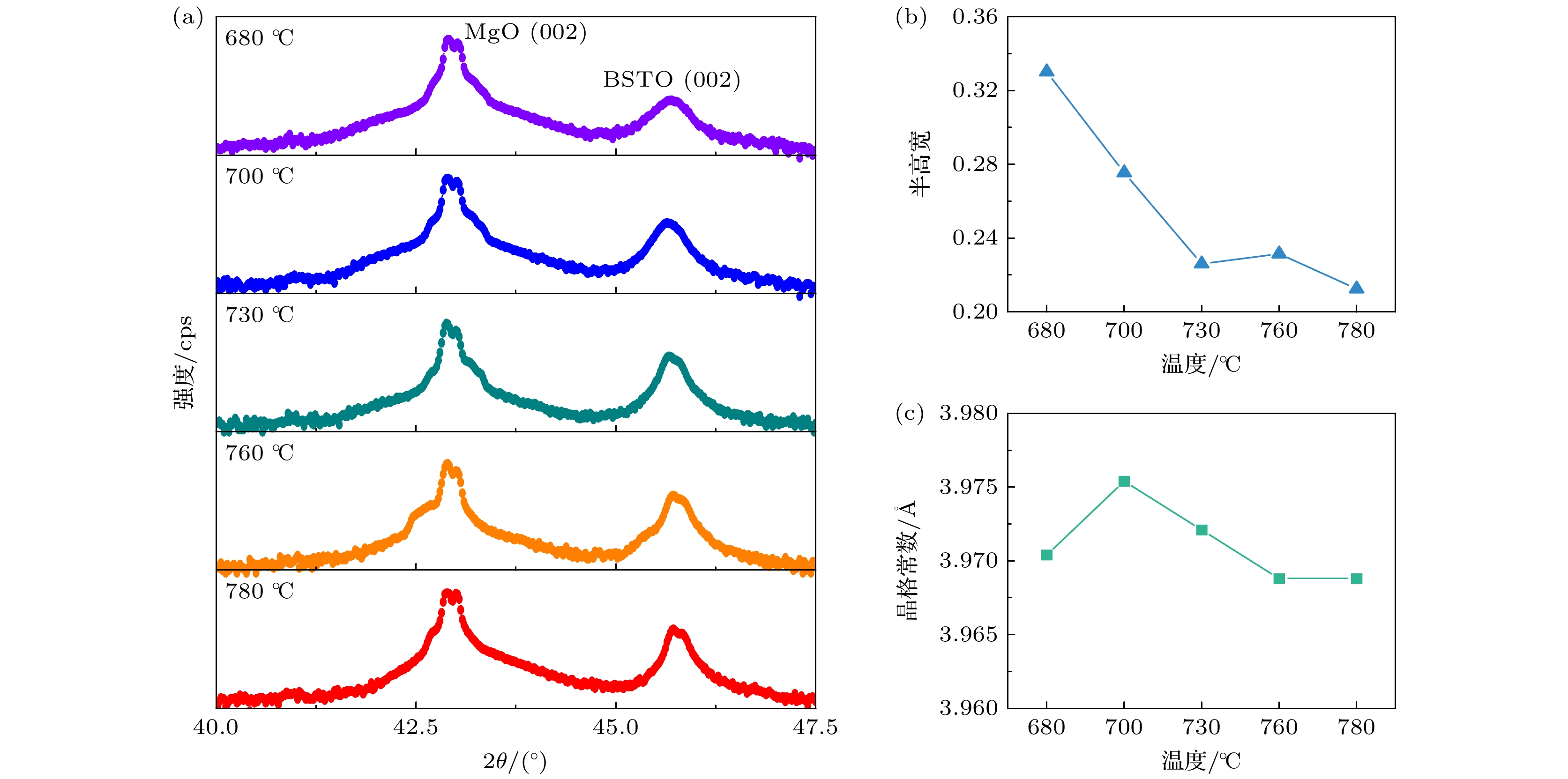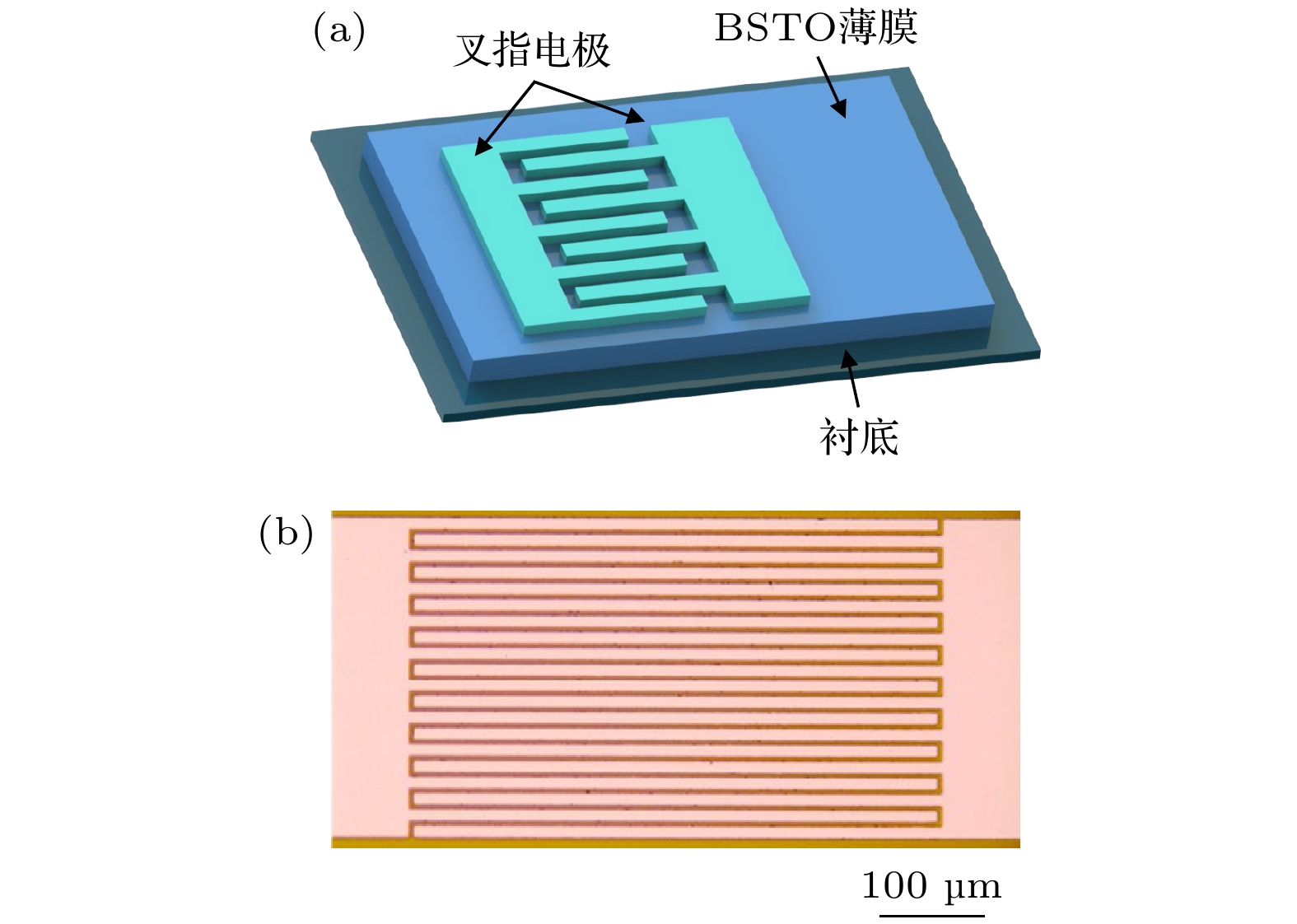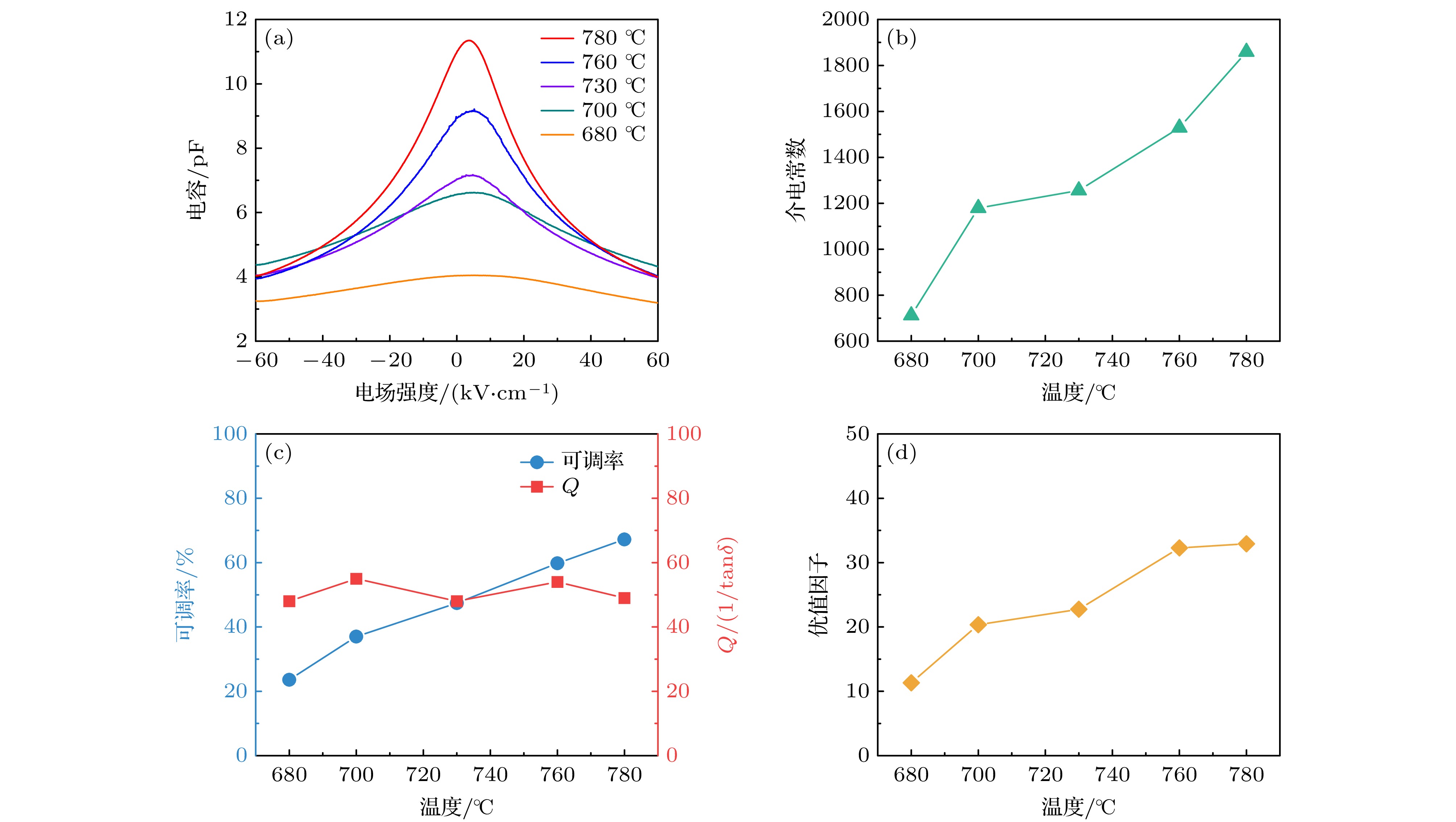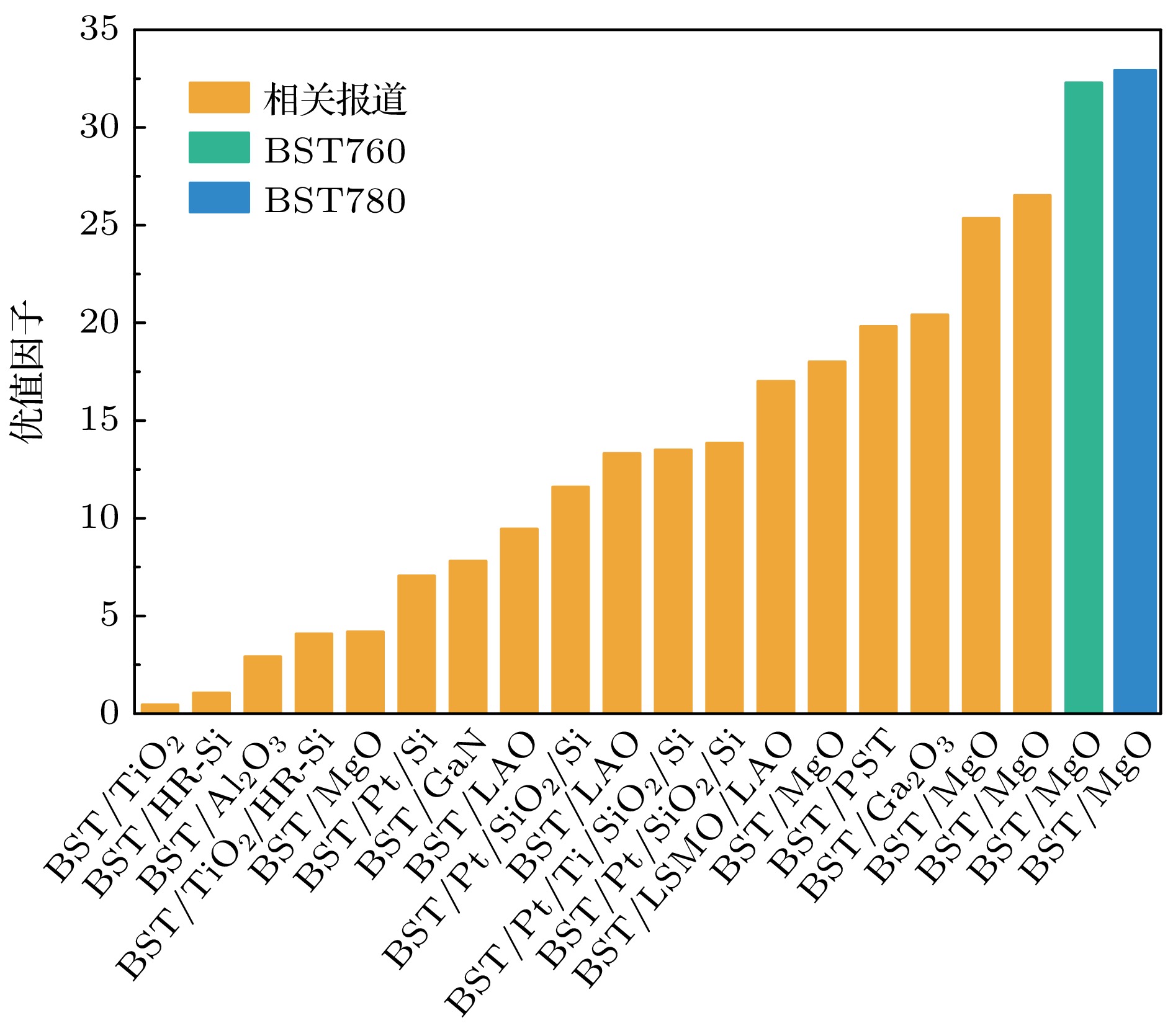-
微波可调器件是相控阵天线和射频前端的重要组成部分, 对于实现频率、相位和幅度的精准控制至关重要. 电介质陶瓷块体材料在微波可调器件中应用广泛, 但不易集成. 电介质薄膜材料具有易集成、低成本、高调谐速率、低功耗、小尺寸、连续可调等优点, 且相比块体材料更易与现代集成电路工艺兼容. 目前, 基于电介质薄膜材料设计器件的前提是: 在提高薄膜结晶质量的同时, 需采用低介电常数和低损耗的材料作为衬底来降低其对整体介电性能的影响. 然而, 适合电介质薄膜外延生长的低介电低损耗衬底(如MgO, Si等)与电介质薄膜晶格失配较大(>5%), 造成高质量外延生长面临较大挑战, 导致难以厘清其本征构效关系, 阻碍了其性能的协同优化, 进而无法获得高可调低损耗的电介质薄膜材料. 因此, 本研究基于激光脉冲沉积技术, 利用畴匹配外延机制在MgO(001)衬底上制备出了高性能的Ba0.6Sr0.4TiO3外延薄膜, 其可调率达到67.2%, 品质因子为49, 优值因子为32.93. 与已有报道相比, 本研究制备的Ba0.6Sr0.4TiO3薄膜表现出更高的介电可调率和更低的介电损耗, 系统地分析了薄膜形貌、晶体结构、温度等因素对其介电性能的影响, 为厘清Ba1–xSrxTiO3薄膜的宽频域构效关系奠定了基础, 凸显了其在可调谐微波器件中的应用潜力.
Microwave tunable devices are critical components in phased array antennas and RF front-ends, and essential for the precise controling of frequency, phase and amplitude. Although bulk dielectric ceramic materials are widely used in these devices, they pose challenges for integration. In contrast, dielectric thin films offer significant advantages, including easy integration, low cost, high tuning speed, low power consumption, compact size, and continuous tunability, making them more compatible with modern integrated circuit fabrication processes. Currently, a key prerequisite for designing devices based on dielectric thin films is the use of low-permittivity, low-loss substrates to mitigate their influence on the overall dielectric performance, while enhancing the crystalline quality of the films themselves. However, suitable substrates for epitaxial growth, such as MgO and Si, exhibit a significant lattice mismatch (>5%) with dielectric thin films. This poses a substantial challenge to achieving high-quality epitaxial growth, making it difficult to obtain dielectric thin films with both high tunability and low loss. To address this challenge, pulsed laser deposition (PLD) is used to provide high-energy, non-equilibrium growth conditions. By precisely controlling parameters such as substrate temperature and growth oxygen pressure, a suitable growth window that induce domain matching epitaxy (DME) mechanism can be determined, effectively adapting to mismatched strain, and thus successfully preparing high-performance Ba0.6Sr0.4TiO3 (BSTO) epitaxial thin films on MgO(001) substrates. To investigate the effect of substrate temperature on the properties of the BSTO thin films, a series of films is prepared on MgO(001) substrates at temperatures of 680 ℃, 700 ℃, 730 ℃, 760 ℃ and 780 ℃, while other growth conditions are kept constant. The study reveals that as the substrate temperature increases, the crystallinity, tunability, and figure of merit (FOM) of the films are significantly improved. The film grown at 780 ℃ shows a high tunability value of 67.2%, a quality (Q) factor of 49, and an FOM of 32.93. Compared with previously reported films, the Ba0.6Sr0.4TiO3 thin films prepared in this work demonstrate superior dielectric tunability and lower dielectric loss. To explore the thermal stability of the Ba0.6Sr0.4TiO3 thin film, its performance is characterized using Raman spectroscopy and Capacitance-Voltage measurements in a temperature range from 25 ℃ to 225 ℃. Raman spectra indicate that the lattice vibrational modes of the Ba0.6Sr0.4TiO3 film change with the increase of temperature. When temperature is in a range between 175 ℃ and 225 ℃, the film will completely transform from the tetragonal phase to the Raman-inactive cubic phase. At the same time, the nonlinear “butterfly” characteristic of the C-V curves vanishes due to the disappearance of ferroelectric domains. The dielectric constant and tunability reach their maximum values at approximately 60 ℃, then decrease, whereas the Q-factor reaches its peak at around 205 ℃. The motion of domain walls in films is constrained not only by internal stress fields and defects but also by strong pinning effects at the film-substrate interface and the free surface of the film. This research systematically analyzes the influences of surface morphology, crystal structure, and temperature on the dielectric properties of Ba0.6Sr0.4TiO3 epitaxial thin films. It lays a foundation for elucidating the broadband structure-property relationships of Ba1–xSrxTiO3 thin films and highlights their significant potential applications in tunable microwave devices. -
Keywords:
- ferroelectric materials /
- strontium barium titanate /
- growth regulation /
- dielectric properties
[1] Emadi F, Nemati A, Hinterstein M, Adabiroozjaei E 2019 Ceram. Int. 45 5503
 Google Scholar
Google Scholar
[2] Borderon C, Ginestar S, Gundel H W, Haskou A, Nadaud K, Renoud R, Sharaiha A 2020 IEEE Trans. Ultrason. Ferroelectr. Freq. Control. 67 1733
 Google Scholar
Google Scholar
[3] 马华, 娄菁, 王军, 董博文, 冯明德, 李智强, 屈绍波 2019 空军工程大学学报 20 53
 Google Scholar
Google Scholar
Ma H, Lou J, Wang J, Dong B W, Feng M D, Li Z Q, Qu S B 2019 J. Air Force Eng. Univ. 20 53
 Google Scholar
Google Scholar
[4] Johnson K M 1962 J. Appl. Phys. 33 2826
 Google Scholar
Google Scholar
[5] Dong H T, Jian J, Li H F, Jin D R, Chen J G, Cheng J R 2017 J. Alloys Compd. 725 54
 Google Scholar
Google Scholar
[6] Bayrak T, Ozgit-Akgun C, Goldenberg E 2017 J. Non-Cryst. Solids 475 76
 Google Scholar
Google Scholar
[7] Subramanyam G, Cole M W, Sun N X, Kalkur T S, Sbrockey N M, Tompa G S, Guo X M, Chen C L, Alpay S P, Rossetti G A Jr, Dayal K, Chen L Q, Schlom D G 2013 J. Appl. Phys. 114 191301
 Google Scholar
Google Scholar
[8] Liu H G, Avrutin V, Zhu C Y, Özgür Ü, Yang J, Lu C Z, Morkoç H 2013 J. Appl. Phys. 113 044108
 Google Scholar
Google Scholar
[9] Luo W, Chen X Y, Fan J W, Hu Y X, Zheng Z P, Fu Q W 2016 Ceram. Int. 42 17229
 Google Scholar
Google Scholar
[10] Jiao T J, You C, Tian N, Ma L, Duan Z F, Yan F X, Ren P R, Zhao G Y 2022 Appl. Surf. Sci. 590 153112
 Google Scholar
Google Scholar
[11] Wang J, Zhang T J, Xia H Y, Xiang J H, Li W K, Duo S W 2008 J. Sol-Gel Sci. Technol. 47 102
 Google Scholar
Google Scholar
[12] Wander A, Bush I J, Harrison N M 2003 Phys. Rev. B 68 233405
 Google Scholar
Google Scholar
[13] Misirlioglu I B, Alpay S P, He F, Wells B O 2006 J. Appl. Phys. 99 104103
 Google Scholar
Google Scholar
[14] Peng L S J, Xi X X, Moeckly B H, Alpay S P 2003 Appl. Phys. Lett. 83 4592
 Google Scholar
Google Scholar
[15] Tagantsev A K, Sherman V O, Astafev K F, Venkatesh J, Setter N 2003 J. Electroceram. 11 5
 Google Scholar
Google Scholar
[16] Acikel B 2002 Ph. D. Dissertation (Santa Barbara: University of California
[17] Su H T, Lancaster M J, Huang F, Wellhofer F 2000 Microwave Opt. Technol. Lett. 24 155
 Google Scholar
Google Scholar
[18] Gao L B, Guan Z P, Huang S X, Liang K X, Chen H W, Zhang J H 2019 J. Mater. Sci. : Mater. Electron. 30 12821
 Google Scholar
Google Scholar
[19] Schultheiß J, Kungl H, Koruza J 2019 J. Appl. Phys. 125 174101
 Google Scholar
Google Scholar
[20] Damjanovic D 1998 Rep. Prog. Phys. 61 1267
 Google Scholar
Google Scholar
[21] 熊沛雨, 倪壮, 林泽丰, 柏欣博, 刘天想, 张翔宇, 袁洁, 王旭, 石兢, 金魁 2023 物理学报 72 097701
 Google Scholar
Google Scholar
Xiong P Y, Ni Z, Lin Z F, Bai X B, Liu T X, Zhang X Y, Yuan J, Wang X, Shi J, Jin K 2023 Acta Phys. Sin. 72 097701
 Google Scholar
Google Scholar
[22] 沈德坤, 杨淄涵, 郭沛源, 赵梦玲, 葛健, 邓功勋, 王爱记 2024 硅酸盐学报 52 229
 Google Scholar
Google Scholar
Shen D K, Yang Z H, Guo P Y, Zhao M L, Ge J, Deng G X, Wang A J 2024 J. Chin. Ceram. Soc. 52 229
 Google Scholar
Google Scholar
[23] Kim H S, Kim H G, Kim I D, Kim K B, Lee J C 2005 Appl. Phys. Lett. 87 212903
 Google Scholar
Google Scholar
[24] Zhang J J, Zhai J W, Chou X J, Shao J, Lu X, Yao X 2009 Acta Mater. 57 4491
 Google Scholar
Google Scholar
[25] Chung U, Elissalde C, Maglione M, Estournès C, Pate M, Ganne J P 2008 Appl. Phys. Lett. 92 042902
 Google Scholar
Google Scholar
[26] Zhu X H, Zheng D N, Peng W, Li J, Chen Y F 2006 Mater. Lett. 60 1224
 Google Scholar
Google Scholar
[27] Gou X L, Gervais M, Gervais F, Catherinot A, Champeaux C, Sabary F 2002 Mater. Sci. Semicond. Process. 5 189
 Google Scholar
Google Scholar
[28] Wang S X, Hao J H, Wu Z P, Wang D Y, Zhuo Y, Zhao X Z 2007 Appl. Phys. Lett. 91 252908
 Google Scholar
Google Scholar
[29] Zhi Y N, Liu D A, Qu W J, Luan Z, Liu L R 2007 Appl. Phys. Lett. 90 042904
 Google Scholar
Google Scholar
[30] Feng Z Y, Chen W, Tan O K 2009 Mater. Res. Bull. 44 1709
 Google Scholar
Google Scholar
[31] Qin W F, Zhu J, Xiong J, Tang J L, Feng X 2007 J. Electron. Sci. Technol. China 5 303
[32] 秦杨晓, 李卓, 梁文学, 刘娜, 赵鹏 2018 压电与声光 40 95
 Google Scholar
Google Scholar
Qin Y X, Li Z, Liang W X, Liu N, Zhao P 2018 Piezoelectr. Acoustoopt. 40 95
 Google Scholar
Google Scholar
[33] Xu Q, Zhang X F, Huang Y H, Chen W, Liu H X, Chen M, Kim B H 2009 J. Alloys Compd. 488 448
 Google Scholar
Google Scholar
[34] 戚炜恒, 王震, 李翔飞, 禹日成, 王焕华 2022 物理学报 71 178103
 Google Scholar
Google Scholar
Qi W H, Wang Z, Li X F, Yu R C, Wang H H 2022 Acta Phys. Sin. 71 178103
 Google Scholar
Google Scholar
[35] 张奇伟, 翟继卫, 岳振星 2013 物理学报 62 237702
 Google Scholar
Google Scholar
Zhang Q W, Zhai J W, Yue Z X 2013 Acta Phys. Sin. 62 237702
 Google Scholar
Google Scholar
[36] Zhang Q W, Zhai J W, Kong L B, Yao X 2012 J. Appl. Phys. 112 124112
 Google Scholar
Google Scholar
[37] Verma A, Raghavan S, Stemmer S, Jena D 2015 Appl. Phys. Lett. 107 192908
 Google Scholar
Google Scholar
[38] 陈渝, 周华将, 谢少雄, 徐倩, 朱建国, 王清远 2021 力学进展 51 755
 Google Scholar
Google Scholar
Chen Y, Zhou H J, Xie S X, Xu Q, Zhu J G, Wang Q Y 2021 Adv. Mech. 51 755
 Google Scholar
Google Scholar
[39] Chen J H, Su X, Yuan T, Tang W B, Ding S C, Shi Y, Li F M, Chen K, Yu Y, Zhang H C, Zhu S Y, Yuan G L, Lu J 2025 Adv. Mater. Interfaces 12 2400949
 Google Scholar
Google Scholar
[40] 唐秋文, 沈明荣, 方亮 2006 物理学报 55 1346
 Google Scholar
Google Scholar
Tang Q W, Shen M R, Fang L 2006 Acta Phys. Sin. 55 1346
 Google Scholar
Google Scholar
[41] Zhu X H, Chong N, Chan H L, Choy C, Wong K, Liu Z G, Ming N B 2002 Appl. Phys. Lett. 80 3376
 Google Scholar
Google Scholar
[42] 吕笑梅, 黄凤珍, 朱劲松 2020 物理学报 69 127704
 Google Scholar
Google Scholar
Lü X M, Huang F Z, Zhu J S 2020 Acta Phys. Sin. 69 127704
 Google Scholar
Google Scholar
[43] Alema F, Pokhodnya K 2015 J. Adv. Dielectr. 5 1550030
 Google Scholar
Google Scholar
[44] Sahoo S K, Misra D, Sahoo M, MacDonald C A, Bakhru H, Agrawal D C, Mohapatra Y N, Majumder S B, Katiyar R S 2011 J. Appl. Phys. 109 064108
 Google Scholar
Google Scholar
[45] Zhang J R, Chen C, Xiang S Q, Zhang J C, Qi Q, Huang R, Yu Y, Chen K, Han Z D, Yuan G L, Liu J M, Zhu J S 2022 Mater. Res. Express 9 106303
 Google Scholar
Google Scholar
-
图 1 不同衬底温度下生长的Ba0.6Sr0.4TiO3薄膜的表面形貌及其表面粗糙度 (a) 680 ℃; (b) 700 ℃; (c) 730 ℃; (d) 760 ℃; (e) 780 ℃; (f) 薄膜的均方根表面粗糙度
Fig. 1. Surface morphology and surface roughness of Ba0.6Sr0.4TiO3 films grown on wafers of different temperatures: (a) 680 ℃; (b) 700 ℃; (c) 730 ℃; (d) 760 ℃; (e) 780 ℃; (f) RMS of films.
图 8 Ba0.6Sr0.4TiO3薄膜在不同测试温度下的介电性能 (a) 零场下的介电常数; (b) $ 1/\varepsilon{\text{-}}T $曲线与居里-外斯定律理论曲线; (c) 可调率; (d) Q值
Fig. 8. Temperature-dependent dielectric properties of Ba0.6Sr0.4TiO3 thin films: (a) Dielectric constant (at 0 kV/cm); (b) $ 1/\varepsilon{\text{-}}T $ and Curie-Weiss law curves; (c) tunability; (d) Q factor.
-
[1] Emadi F, Nemati A, Hinterstein M, Adabiroozjaei E 2019 Ceram. Int. 45 5503
 Google Scholar
Google Scholar
[2] Borderon C, Ginestar S, Gundel H W, Haskou A, Nadaud K, Renoud R, Sharaiha A 2020 IEEE Trans. Ultrason. Ferroelectr. Freq. Control. 67 1733
 Google Scholar
Google Scholar
[3] 马华, 娄菁, 王军, 董博文, 冯明德, 李智强, 屈绍波 2019 空军工程大学学报 20 53
 Google Scholar
Google Scholar
Ma H, Lou J, Wang J, Dong B W, Feng M D, Li Z Q, Qu S B 2019 J. Air Force Eng. Univ. 20 53
 Google Scholar
Google Scholar
[4] Johnson K M 1962 J. Appl. Phys. 33 2826
 Google Scholar
Google Scholar
[5] Dong H T, Jian J, Li H F, Jin D R, Chen J G, Cheng J R 2017 J. Alloys Compd. 725 54
 Google Scholar
Google Scholar
[6] Bayrak T, Ozgit-Akgun C, Goldenberg E 2017 J. Non-Cryst. Solids 475 76
 Google Scholar
Google Scholar
[7] Subramanyam G, Cole M W, Sun N X, Kalkur T S, Sbrockey N M, Tompa G S, Guo X M, Chen C L, Alpay S P, Rossetti G A Jr, Dayal K, Chen L Q, Schlom D G 2013 J. Appl. Phys. 114 191301
 Google Scholar
Google Scholar
[8] Liu H G, Avrutin V, Zhu C Y, Özgür Ü, Yang J, Lu C Z, Morkoç H 2013 J. Appl. Phys. 113 044108
 Google Scholar
Google Scholar
[9] Luo W, Chen X Y, Fan J W, Hu Y X, Zheng Z P, Fu Q W 2016 Ceram. Int. 42 17229
 Google Scholar
Google Scholar
[10] Jiao T J, You C, Tian N, Ma L, Duan Z F, Yan F X, Ren P R, Zhao G Y 2022 Appl. Surf. Sci. 590 153112
 Google Scholar
Google Scholar
[11] Wang J, Zhang T J, Xia H Y, Xiang J H, Li W K, Duo S W 2008 J. Sol-Gel Sci. Technol. 47 102
 Google Scholar
Google Scholar
[12] Wander A, Bush I J, Harrison N M 2003 Phys. Rev. B 68 233405
 Google Scholar
Google Scholar
[13] Misirlioglu I B, Alpay S P, He F, Wells B O 2006 J. Appl. Phys. 99 104103
 Google Scholar
Google Scholar
[14] Peng L S J, Xi X X, Moeckly B H, Alpay S P 2003 Appl. Phys. Lett. 83 4592
 Google Scholar
Google Scholar
[15] Tagantsev A K, Sherman V O, Astafev K F, Venkatesh J, Setter N 2003 J. Electroceram. 11 5
 Google Scholar
Google Scholar
[16] Acikel B 2002 Ph. D. Dissertation (Santa Barbara: University of California
[17] Su H T, Lancaster M J, Huang F, Wellhofer F 2000 Microwave Opt. Technol. Lett. 24 155
 Google Scholar
Google Scholar
[18] Gao L B, Guan Z P, Huang S X, Liang K X, Chen H W, Zhang J H 2019 J. Mater. Sci. : Mater. Electron. 30 12821
 Google Scholar
Google Scholar
[19] Schultheiß J, Kungl H, Koruza J 2019 J. Appl. Phys. 125 174101
 Google Scholar
Google Scholar
[20] Damjanovic D 1998 Rep. Prog. Phys. 61 1267
 Google Scholar
Google Scholar
[21] 熊沛雨, 倪壮, 林泽丰, 柏欣博, 刘天想, 张翔宇, 袁洁, 王旭, 石兢, 金魁 2023 物理学报 72 097701
 Google Scholar
Google Scholar
Xiong P Y, Ni Z, Lin Z F, Bai X B, Liu T X, Zhang X Y, Yuan J, Wang X, Shi J, Jin K 2023 Acta Phys. Sin. 72 097701
 Google Scholar
Google Scholar
[22] 沈德坤, 杨淄涵, 郭沛源, 赵梦玲, 葛健, 邓功勋, 王爱记 2024 硅酸盐学报 52 229
 Google Scholar
Google Scholar
Shen D K, Yang Z H, Guo P Y, Zhao M L, Ge J, Deng G X, Wang A J 2024 J. Chin. Ceram. Soc. 52 229
 Google Scholar
Google Scholar
[23] Kim H S, Kim H G, Kim I D, Kim K B, Lee J C 2005 Appl. Phys. Lett. 87 212903
 Google Scholar
Google Scholar
[24] Zhang J J, Zhai J W, Chou X J, Shao J, Lu X, Yao X 2009 Acta Mater. 57 4491
 Google Scholar
Google Scholar
[25] Chung U, Elissalde C, Maglione M, Estournès C, Pate M, Ganne J P 2008 Appl. Phys. Lett. 92 042902
 Google Scholar
Google Scholar
[26] Zhu X H, Zheng D N, Peng W, Li J, Chen Y F 2006 Mater. Lett. 60 1224
 Google Scholar
Google Scholar
[27] Gou X L, Gervais M, Gervais F, Catherinot A, Champeaux C, Sabary F 2002 Mater. Sci. Semicond. Process. 5 189
 Google Scholar
Google Scholar
[28] Wang S X, Hao J H, Wu Z P, Wang D Y, Zhuo Y, Zhao X Z 2007 Appl. Phys. Lett. 91 252908
 Google Scholar
Google Scholar
[29] Zhi Y N, Liu D A, Qu W J, Luan Z, Liu L R 2007 Appl. Phys. Lett. 90 042904
 Google Scholar
Google Scholar
[30] Feng Z Y, Chen W, Tan O K 2009 Mater. Res. Bull. 44 1709
 Google Scholar
Google Scholar
[31] Qin W F, Zhu J, Xiong J, Tang J L, Feng X 2007 J. Electron. Sci. Technol. China 5 303
[32] 秦杨晓, 李卓, 梁文学, 刘娜, 赵鹏 2018 压电与声光 40 95
 Google Scholar
Google Scholar
Qin Y X, Li Z, Liang W X, Liu N, Zhao P 2018 Piezoelectr. Acoustoopt. 40 95
 Google Scholar
Google Scholar
[33] Xu Q, Zhang X F, Huang Y H, Chen W, Liu H X, Chen M, Kim B H 2009 J. Alloys Compd. 488 448
 Google Scholar
Google Scholar
[34] 戚炜恒, 王震, 李翔飞, 禹日成, 王焕华 2022 物理学报 71 178103
 Google Scholar
Google Scholar
Qi W H, Wang Z, Li X F, Yu R C, Wang H H 2022 Acta Phys. Sin. 71 178103
 Google Scholar
Google Scholar
[35] 张奇伟, 翟继卫, 岳振星 2013 物理学报 62 237702
 Google Scholar
Google Scholar
Zhang Q W, Zhai J W, Yue Z X 2013 Acta Phys. Sin. 62 237702
 Google Scholar
Google Scholar
[36] Zhang Q W, Zhai J W, Kong L B, Yao X 2012 J. Appl. Phys. 112 124112
 Google Scholar
Google Scholar
[37] Verma A, Raghavan S, Stemmer S, Jena D 2015 Appl. Phys. Lett. 107 192908
 Google Scholar
Google Scholar
[38] 陈渝, 周华将, 谢少雄, 徐倩, 朱建国, 王清远 2021 力学进展 51 755
 Google Scholar
Google Scholar
Chen Y, Zhou H J, Xie S X, Xu Q, Zhu J G, Wang Q Y 2021 Adv. Mech. 51 755
 Google Scholar
Google Scholar
[39] Chen J H, Su X, Yuan T, Tang W B, Ding S C, Shi Y, Li F M, Chen K, Yu Y, Zhang H C, Zhu S Y, Yuan G L, Lu J 2025 Adv. Mater. Interfaces 12 2400949
 Google Scholar
Google Scholar
[40] 唐秋文, 沈明荣, 方亮 2006 物理学报 55 1346
 Google Scholar
Google Scholar
Tang Q W, Shen M R, Fang L 2006 Acta Phys. Sin. 55 1346
 Google Scholar
Google Scholar
[41] Zhu X H, Chong N, Chan H L, Choy C, Wong K, Liu Z G, Ming N B 2002 Appl. Phys. Lett. 80 3376
 Google Scholar
Google Scholar
[42] 吕笑梅, 黄凤珍, 朱劲松 2020 物理学报 69 127704
 Google Scholar
Google Scholar
Lü X M, Huang F Z, Zhu J S 2020 Acta Phys. Sin. 69 127704
 Google Scholar
Google Scholar
[43] Alema F, Pokhodnya K 2015 J. Adv. Dielectr. 5 1550030
 Google Scholar
Google Scholar
[44] Sahoo S K, Misra D, Sahoo M, MacDonald C A, Bakhru H, Agrawal D C, Mohapatra Y N, Majumder S B, Katiyar R S 2011 J. Appl. Phys. 109 064108
 Google Scholar
Google Scholar
[45] Zhang J R, Chen C, Xiang S Q, Zhang J C, Qi Q, Huang R, Yu Y, Chen K, Han Z D, Yuan G L, Liu J M, Zhu J S 2022 Mater. Res. Express 9 106303
 Google Scholar
Google Scholar
计量
- 文章访问数: 2226
- PDF下载量: 73
- 被引次数: 0













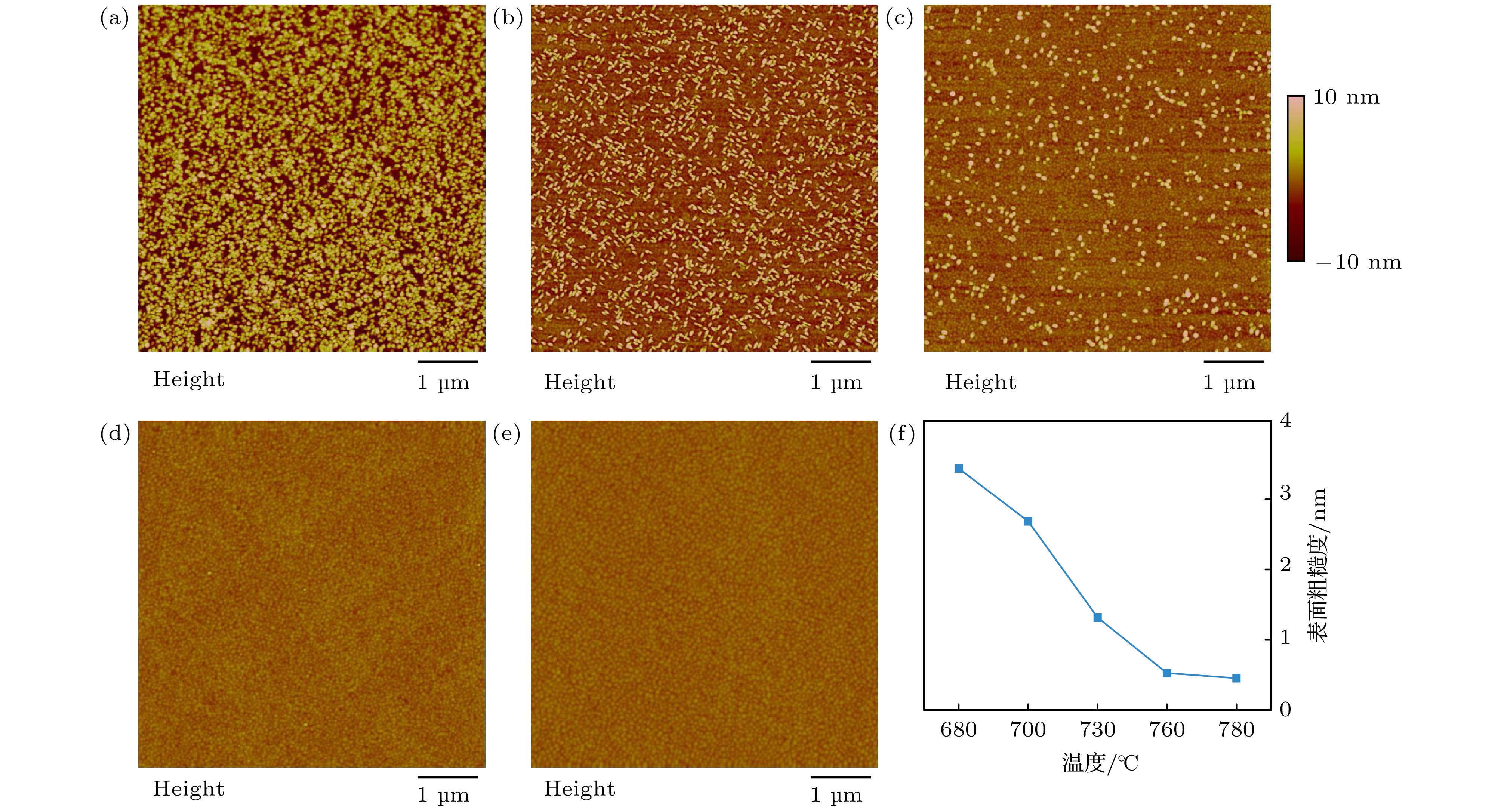
 下载:
下载:
